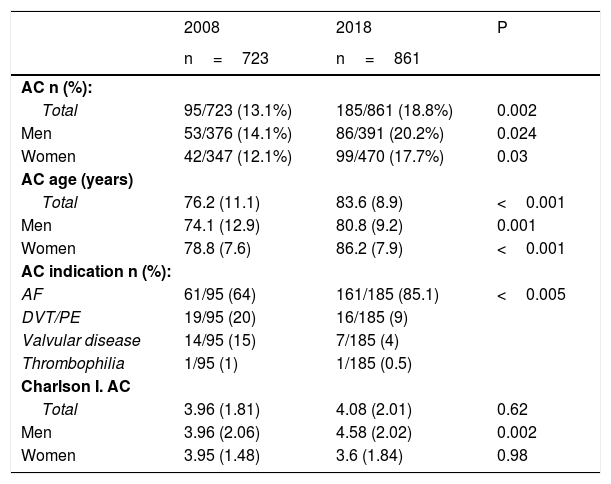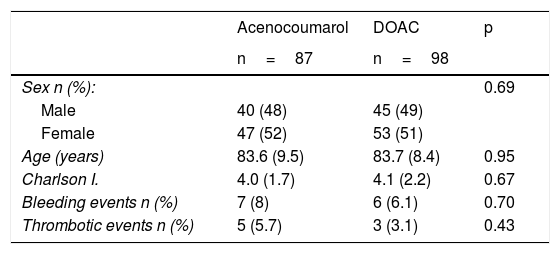The use of direct oral anticoagulants (DOACs) has modified anticoagulant therapy guidelines.
ObjectivesTo determine changes and trends in the anticoagulant therapy of inpatients at an Internal medicine department.
Material and methods1584 inpatients of the internal medicine department (Hospital Marqués de Valdecilla. Santander) were studied in 2008 and 2018. The use of anticoagulant treatment, type of treatment, atrial fibrillation, comorbidity index, thrombotic and haemorrhagic complications were collected from the discharge reports.
ResultsThe prevalence of anticoagulants increased by 5.7% (13.1% to 18.8%; p=0.002). The mean age increased by 7 years (76.2±11.1 yrs. vs. 83.6±8.9 yrs; p<0.001). The percentage of anticoagulated patients older than 75 yrs doubled. In 2018, 52% of anticoagulated in patients took an DOAC. The prevalence of atrial fibrillation increased by 4% (30% vs. 34%; p=0.04) and by 24% that of anticoagulated atrial fibrillation by 24% (32.3% vs. 56%; p=7.2×10-8). The mean age is 6 years older (78.4±8.2 vs. 84.2±8.0; p<0.001).
ConclusionsThe percentage of anticoagulated patients in internal medicine has increased, especially in those with atrial fibrillation.
Los anticoagulantes orales de acción directa (ACOD) han modificado el tratamiento anticoagulante.
ObjetivosConocer los cambios y tendencias producidos en la anticoagulación en medicina interna.
Material y métodosSe estudiaron 1.584 ingresos en medicina interna (Hospital Marqués de Valdecilla. Santander) en 2008 y 2018. Se recogió el tratamiento anticoagulante, indicación y tipo, fibrilación auricular, complicaciones a 6 meses y mortalidad a 2 años.
ResultadosLa prevalencia de anticoagulados aumentó un 5,7% (13,1% vs. 18,8%; p=0,002), la media de edad fue 7 años mayor (76,2±11,1 vs. 83,6±8,9; p<0,001). Se duplicaron los anticoagulados mayores de 75 años. En el 2018 el 52% de los anticoagulados tomaban un ACOD. En 10 años aumentó la prevalencia de fibrilación auricular un 4% (30% vs. 34%; p=0,04) y la de fibrilación auricular anticoagulada un 24% (32,3% vs. 56%; p<0,001). La media de edad fue 6 años mayor (78,4±8,2 vs. 84,2±8,0; p<0,001).
ConclusionesHa aumentado el porcentaje de pacientes anticoagulados en medicina interna, sobre todo en aquellos con fibrilación auricular.










